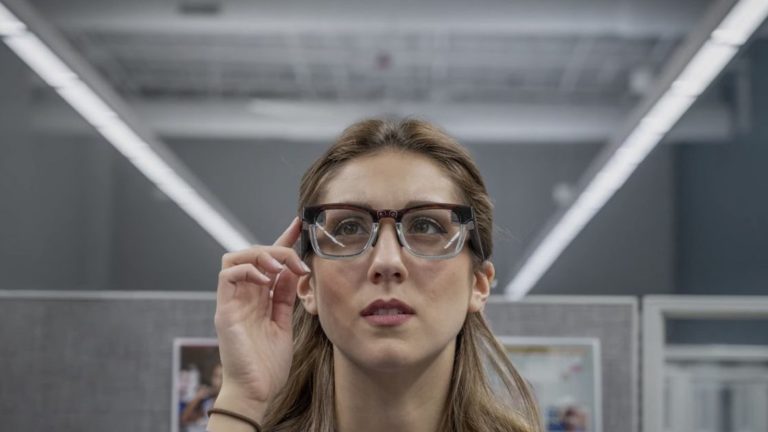
A
R traction over the past few years has occurred mostly through the smartphone camera. As our research arm ARtillery Intelligence quantified in its mobile AR revenue forecast, this early AR modality has reached scale by piggy-backing on a ubiquitous device we all carry.
But that scale has a tradeoff. Mobile AR’s quantitative benefits come with qualitative detriments. Though AR enjoys mobile’s sheer reach, smartphones aren’t the technology’s optimal vessel. There, AR is overshadowed by other established and primary smartphone activities.
Beyond taking a back seat to other mobile use cases, AR’s use on smartphones can be awkward and un-ergonomic. Arm fatigue sets in through the act of holding one’s phone up for long periods to experience line-of-sight graphical overlays. This keeps session lengths relatively short.
At the same time, AR glasses aren’t ready for prime time. At one end of the spectrum is hardware that’s graphically compelling but stylistically untenable (think: Hololens). At the other end is hardware that’s sleek but underwhelming in graphical intensity (think: North Focals).
What will it take to get over that hump? Will Apple’s rumored glasses accelerate things? And how many years will this process take? ARtillery tackles these questions in its report, Smart Glasses, the Road to AR’s Holy Grail, which is excerpted below for AR Insider readers.
Smart Glasses: The Road to AR’s Holy Grail
Design Tradeoff
Over the past few years, a realization has begun to sink into the AR sector. After years of excitement over the impending era of world-immersive AR, there’s growing consensus that the technology is still far from bringing that dream to a pair of glasses that most people will wear.
This comes down to a classic design tradeoff, as noted above. Visually immersive and contextually-aware AR glasses like Microsoft Hololens 2 require optics whose power consumption and heat dissipation necessitate bulky headgear, rather than anything you’d consider “eyewear.”
At the other end of the spectrum is hardware such as North Focals. Inverse to the above examples, these lack immersion and contextual awareness, but they’re stylistically-viable. Between these endpoints is a sliding scale where we see glasses like Nreal Light.
What Are AR Glasses’ Impediments to Scale?
Common Point of Value
The North approach could be right for today’s AR glasses if viewing product evolution in light of historical examples. In other words, consider the iPhone 1 which launched with relatively few features and apps, no GPS, low-quality camera, and other gaps that were gradually filled.
Going back farther, smartphones didn’t start with the iPhone, as earlier iterations from RIM and Windows Mobile let you make calls and send e-mail on the go. And feature phones before them gained rapid ubiquity with the simple value proposition of calls or texts from anywhere.
Throughout this progression, there was one common point of value: mobility. Whether it’s calls, texts, email, web browsing, summoning Uber or swiping Tinder, mobility has sustained as the core value proposition — albeit increasingly dressed in incremental value over time.
Applying that principle to AR, could wearability be the next era’s mobility? And if so, should it represent AR glasses’ V1 design target, which evolves over time towards advanced AR functionality? That’s opposed to starting with advanced AR then sizing-down towards wearability.
Evidence in today’s market support this play. As examined last week, the latest signals for Apple’s AR glasses indicate regular glasses that eschew a Magic Leap-style AR experience in favor of simpler optical enhancements like helping you see better.
Apple Glass: Chasing Clues for the ‘What’ and ‘When’
Glasses+
These concepts have been bouncing around in industry discussions, events, and ongoing rhetoric of late. But for us, it coalesced during a recent discussion with Ostendo VP Jason McDowall. You may know McDowall as producer and host of the AR Show Podcast.
McDowall believes AR glasses will verticalize to some degree, especially in the enterprise. In other words, one monolithic Hololens that’s used across manufacturing, medicine, and education, could give way to glasses that are purpose-built for the nuances of each field.
Whether it’s for consumers or enterprises, the point is that all-day wearable displays need to have UX endpoints in mind, as they impact key development decisions. Here, McDowall identifies three pillars for AR’s: hands-free, contextual insight, and just-in-time.
The hands-free pillar is covered in the wearability principle. Contextual insight is the “defining lever of value” says McDowall, involving situationally-aware content that can be visual, audible, or haptic. And the just-in-time pillar is all about having it delivered intelligently when needed.
But of all these design targets, wearability may have to come first to get consumers to put them on. Here, irony lies in the term “smart glasses” itself. Taking the term literally, do we first need smarter glasses….as in, slightly-smarter tech-fueled versions of today’s eyewear?
“A good way to get consumer wearable displays into the mainstream is to start with the functionality of glasses,” said McDowall, “and make them a little bit better….glasses+.”

